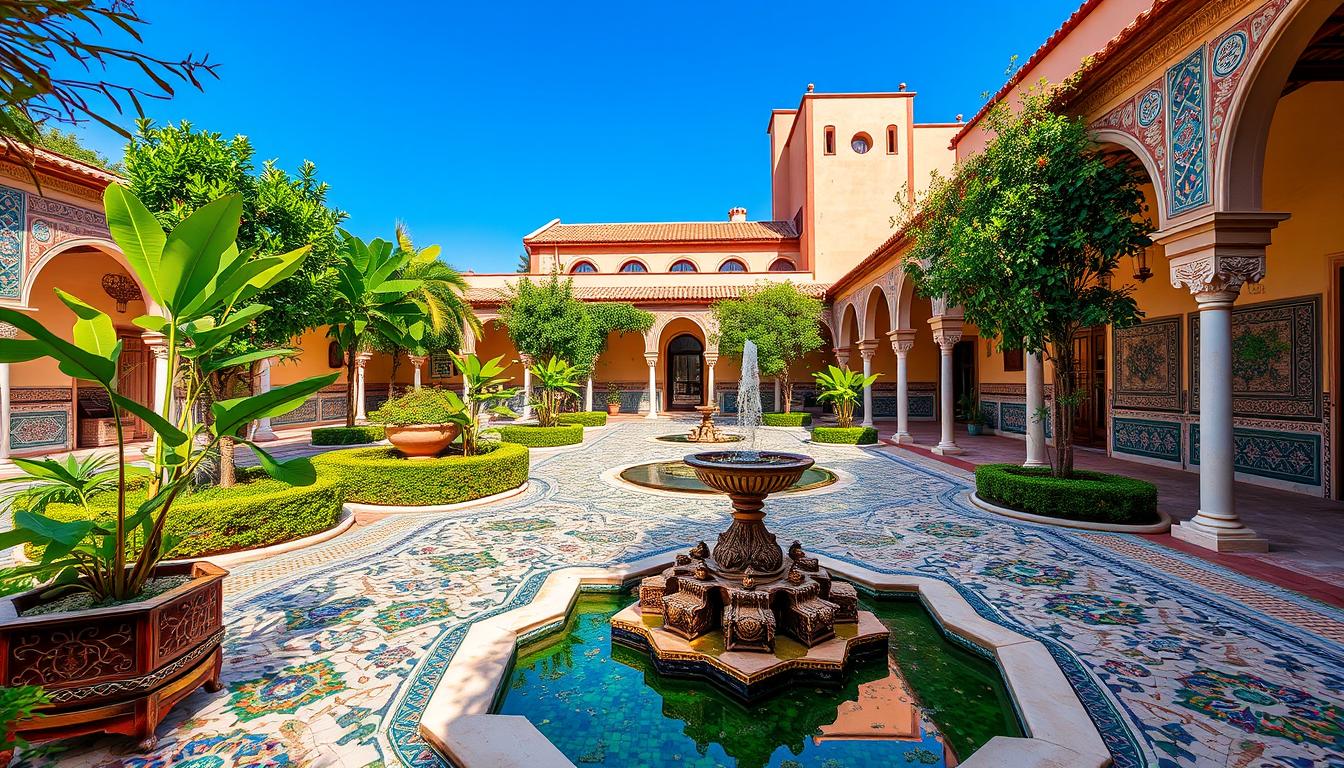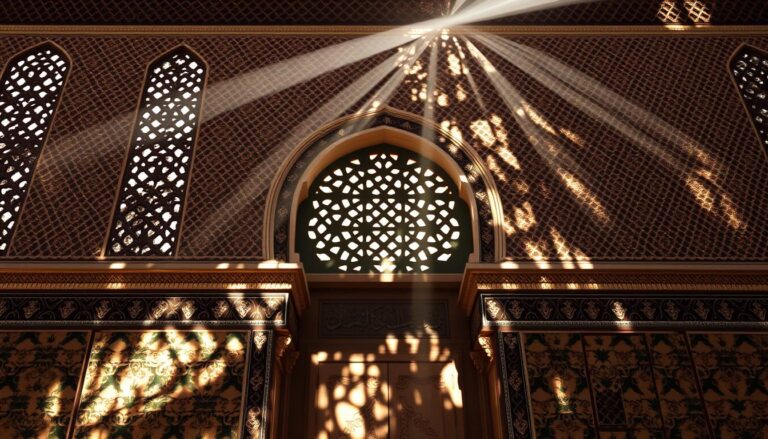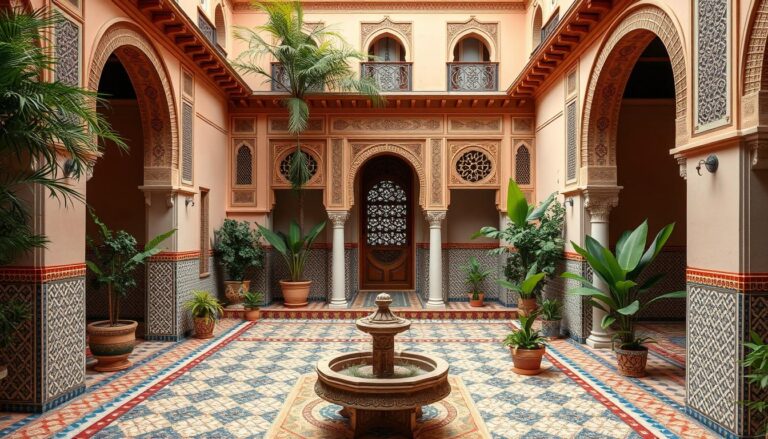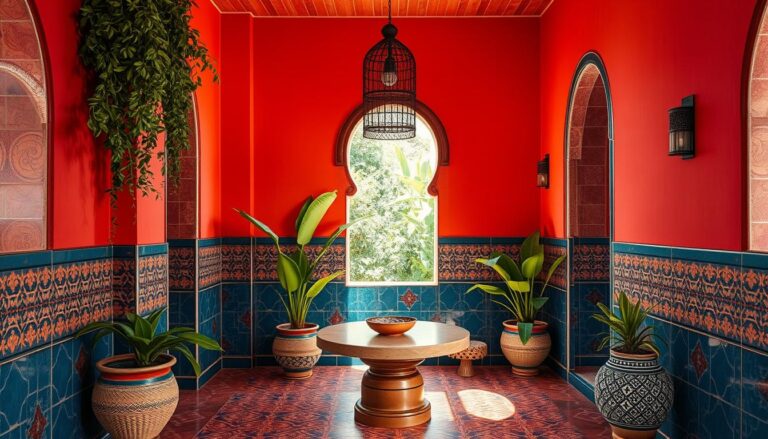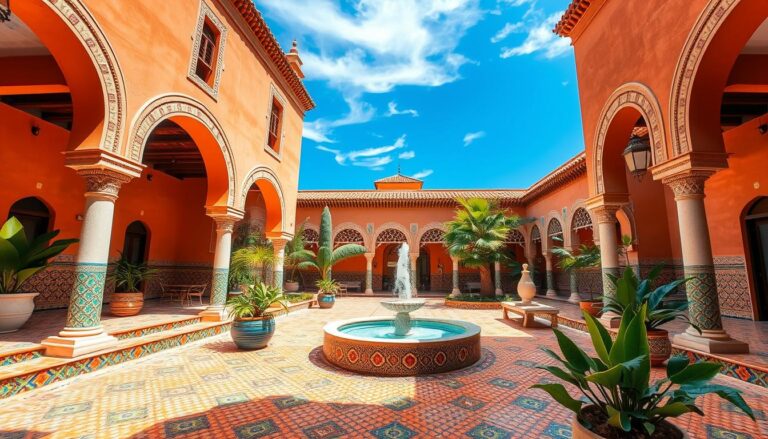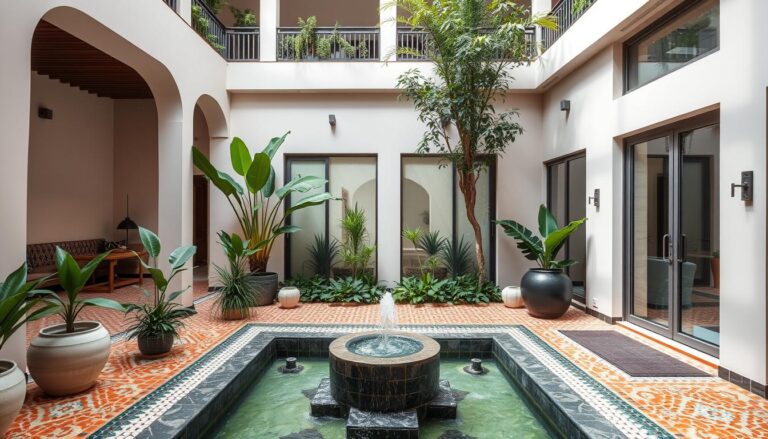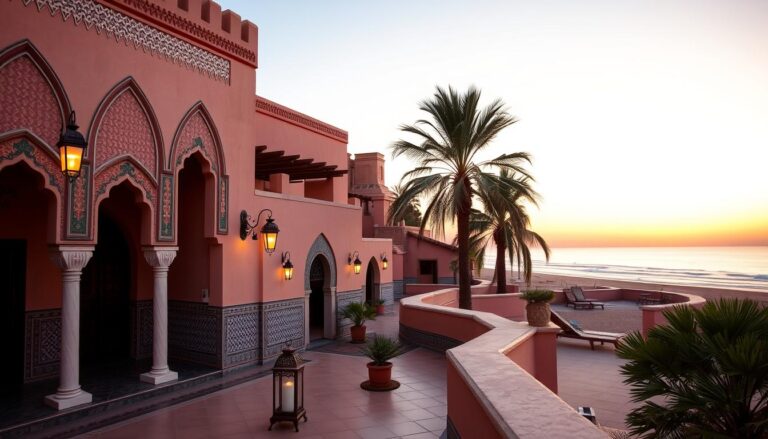Imagine stepping into a serene oasis. Here, the gentle flow of water blends with Moroccan tiles and lush gardens. This captures the essence of Moroccan architecture, where water features are key. They shape the design and ambiance of these structures.
But what’s the story behind water’s role in Moroccan design? How have different cultures influenced this unique architectural legacy?
Key Takeaways
- Water is a vital part of Moroccan architecture, showing the cultural and historical influences that have shaped it.
- Moroccan architecture combines Berber, Islamic, Moorish, and French colonial styles. Each adds to the importance of water features.
- Features like serene fountains, intricate riads, and zellige tilework are hallmarks of Moroccan architecture.
- The significance of water in Islamic design and the contrast of red clay and blue sky in Berber architecture are key. Moorish and French colonial styles also play a role in Moroccan water features.
- Moroccan water fountains, with their intricate designs and vibrant colors, showcase the country’s rich architectural heritage. They highlight the lasting importance of water in its design.
Introduction to Moroccan Water Features
Water is very important in Moroccan architecture. It stands for purity, peace, and a link to the divine. You can find many fountains, pools, and water features in buildings and public areas. They show how much people value water.
The Significance of Water in Islamic Architecture
In Islamic architecture, water is highly valued. It symbolizes spiritual cleansing and the bond between the world and the divine. This is seen in Moroccan design, like the calm fountains in palace courtyards and the peaceful pools that reflect the buildings.
The Influence of Different Cultures on Moroccan Design
Moroccan architecture is a mix of cultures. It includes Berber traditions, Islamic Moorish heritage, and French colonial influences. Each culture has shaped how water is used in Moroccan design. This has created a variety of architectural styles and water features that show the country’s rich history.
Water is key in Moroccan architecture, from ancient Berber kasbahs to grand Moorish mosques and French-influenced buildings. The blend of cultures has made a beautiful and unique architectural landscape. Water features are both practical and symbolic in this landscape.
Berber Influences: Kasbahs and Fortified Villages
The Berber, or Amazigh, people have shaped Moroccan architecture for centuries. Their kasbahs and fortified villages, made from sun-dried red clay bricks, stand out against the Atlas Mountains’ deep blue sky.
The Striking Contrast of Red Clay and Blue Sky
These structures, with their thick walls and detailed patterns, fit perfectly into the landscape. Using local materials like red clay, they reflect the area’s natural beauty. This creates a stunning look that’s become a hallmark of Moroccan design.
Ait Benhaddou: A UNESCO-Listed Clay Masterpiece
Ait Benhaddou, a UNESCO-listed village, is a prime example of Berber architecture. It’s a well-kept clay masterpiece that has been featured in many films. This kasbah shows the Berbers’ skill in building strong, water-smart structures.
“Ait Benhaddou is a striking example of the Berbers’ architectural prowess, seamlessly blending form and function to create a truly captivating masterpiece.”
Though built for defense, these kasbahs and villages also show the Berbers’ knowledge of their surroundings. They built structures that were both beautiful and practical.
Islamic Influences: Geometric Patterns and Paradise Gardens
The arrival of Islam in Morocco changed its architecture a lot. It brought geometric patterns, zellij tiles, and the idea of paradise gardens. Moroccan zellij tiles are famous for their bright colors and detailed designs. They cover both inside and outside of buildings everywhere.
Floral arabesques carved in stone and wood also decorate these buildings. They add a natural beauty to the structures.
The Beauty of Zellij Tilework and Floral Arabesques
Zellij tilework is a key feature of Moroccan Islamic architecture. These tiles, in blues, greens, and whites, create stunning patterns. They catch the eye and amaze everyone who sees them.
The floral arabesques carved in stone and wood add elegance. They mix the precision of math with the softness of nature.
Hassan II Mosque: A Towering Architectural Marvel
The Hassan II Mosque in Casablanca is a prime example of Islamic influence in Moroccan architecture. This massive mosque shows off Moroccan Islamic design at its best. Its geometric patterns and zellij tiles are awe-inspiring.
The mosque’s size and detail show Morocco’s rich architectural history. It’s a true marvel.
“The integration of geometric patterns, intricate tilework, and the concept of the paradise garden into Moroccan architecture is a true testament to the enduring influence of Islam on the country’s built environment.”
Water features in Moroccan architecture
Moroccan architecture is famous for its stunning water features. These reflect the deep cultural and religious value of water in Islamic design. Fountains, with their detailed tilework and geometric patterns, are everywhere. They add beauty and function to the spaces.
The Role of Fountains in Islamic Design
Fountains in Moroccan architecture are more than just decorations. They are key in the ritual purification before prayers. The sound of flowing water and the beauty of these structures bring peace to the spaces.
Riads: Tranquil Courtyards with Water Features
The traditional Moroccan house, called a riad, has a central courtyard with a water feature. These peaceful spots, hidden from the city’s noise, offer a calm retreat. The use of water in riads shows the importance of nature and balance in Islamic architecture.
“Concrete pavers, also known as ‘zellige,’ were used to tile the interior and exterior surfaces of buildings, tanks, vases, fountains, and dishes.”
Moroccan architecture’s water features are symbols of the country’s rich culture and Islamic design’s lasting impact.
Moorish Influences: Stucco, Arches, and Tilework
The Moors, an Islamic Berber group, lived in Spain and Morocco for many years. They left a lasting impact on Moroccan architecture. You can see this in the white stucco walls, red roofs, and unique arches on many Moroccan landmarks.
The Moors also brought intricate tilework, called zellij, to their buildings. This tilework mixes Islamic and Andalusian styles. It’s known for its detailed patterns and flowers, making Moorish Moroccan architecture special.
Chefchaouen’s Grand Mosque: A Moorish Masterpiece
The Grand Mosque in Chefchaouen is a prime example of Moorish architecture. It has an octagonal minaret and beautiful ceramic tiles. This mosque shows the Moors’ lasting effect on Moroccan design and beauty.
“The Moorish architectural traditions continued in North Africa and the Mudéjar style in Spain, adapting designs for Christian patrons.”
The Moors’ influence on Moroccan architecture has lasted for centuries. It ranges from the red-clay Berber villages to the grand mosques and beautiful gardens of the Islamic elite. Their use of stucco, arches, and tilework still amazes visitors and inspires designers today. This ensures the Moorish style remains a key part of Morocco’s architectural heritage.
French Colonial Influences: Balconies and Art Nouveau
From 1912 to 1956, Morocco’s architecture changed a lot thanks to the French. They brought in big double doors and windows. They also made buildings focus on outdoor areas and balconies.
This mix of styles created a new look called Mauresque or Neo-Moorish. It combined Moroccan traditions with European designs.
The Introduction of Large Windows and Outdoor Spaces
The French changed Moroccan buildings by adding big windows and outdoor areas. Before, Moroccan buildings had smaller openings and were more closed off. French-style balconies and terraces made spaces feel more open and airy.
Casablanca’s Art Deco and Neo-Moorish Architecture
In Casablanca, you see a special mix of Art Deco and Neo-Moorish styles. Art Deco buildings have sleek lines and shapes. Neo-Moorish buildings use Moroccan features like arches and tilework.
This mix shows how cultures blended during the French colonial time. It’s a beautiful example of architectural fusion.
“The French colonial influence on Moroccan architecture is a testament to the cultural exchange that took place during that era, resulting in a unique blend of styles that continue to captivate visitors today.”
Conclusion
Moroccan architecture is a mix of many cultures, each adding its own touch. Water features are a big part of this mix. From Berber kasbahs to Islamic gardens, water has shaped Moroccan buildings.
The Hassan II Mosque in Casablanca is a great example. It has a huge minaret and can hold thousands. Tours of the mosque let visitors learn about its history and design.
Water features in Moroccan architecture show the country’s deep connection to its culture. When travelers see the kasbahs, riads, and mosques, they see more than beauty. They see the lasting role of water in Moroccan life and identity.
Source Links
- The Rich and Vibrant History of Moroccan Architecture.
- Green Water Fountain with Tree of Life Design – MF824
- Moroccan architecture
- From Islamic to Art Deco: A rich history of Moroccan architecture
- Exploring the Richness of Moroccan Architecture – Cindrebay
- What is a Kasbah? A Comprehensive Guide to Morocco’s Ancient Fortresses
- What Type of Architecture Is Morocco Known for?
- A Dialogue in Art and Architecture: Morocco and Spain | IES Abroad
- Islamic garden
- Islamic arts – Moorish, Architecture, Decoration | Britannica
- Moroccan Art and Architecture, Traditional & Modern Styles
- Moorish architecture
- Bohemian & Morrocan Interior Design – The Ultimate Guide
- See the Marjorelle Garden in Marrakech, restored by French designer Yves Saint-Laurent
- Urban Adventure’s Walking Tour of Casablanca – Happy Days Travel
- Casablanca Nostalgia.
- Moroccan Architecture – Planet Marrakech
- Discovering the Beautiful Architecture of Hassan II Mosque

The Editorial Team is a passionate group of Morocco enthusiasts dedicated to sharing the beauty, culture, and wonders of this captivating country. With diverse backgrounds and a deep love for travel, we strive to bring you engaging and informative content that inspires your Moroccan adventures. From uncovering hidden gems and sharing local insights to exploring mouthwatering cuisine and showcasing the vibrant lifestyle, our team is committed to providing you with valuable resources and exciting stories that enhance your exploration of Morocco. Join us on this journey as we celebrate the rich heritage and unforgettable experiences that make Morocco truly special.

